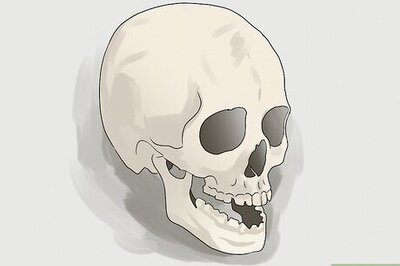
views
Achelois
Achelois is a goddess of healing and the moon. She is one of several moon goddesses, and as such, she’s associated with the monthly lunar cycle. Her name is often translated as “she who casts away pain,” so she’s thought to have the ability to soothe pain and heal injuries.
Achelous
Achelous is a shape-shifting river god. He is thought to be the personification of the Achelous River, which runs through western Greece and empties into the Ionian Sea. Achelous was considered chief among the other rivers and springs, which each had their own deities too.
Adonis
Adonis is the god of beauty, desire, and rebirth. According to legend, Adonis started out as a human man before being worshipped as a god. Enchanted by his beauty, Aphrodite captured him when he was young and gave him to Persephone, Queen of the Underworld, to raise. Persephone ended up falling in love with Adonis too, so an agreement eventually had to be reached. With Zeus’s help, it was decided that Adonis would spend part of the year with each of the goddesses.
Aether
Aether is a god of light and the sky. In Greek mythology, Aether is the son of Nyx (goddess of the night). He is associated with the upper atmosphere, high above the air we breathe on Earth. Each night, his mother Nyx was believed to draw the curtain of darkness (Erebus) across the world, hiding Aether from sight. In the morning Aether’s sister Hemera (goddess of daytime) would waft away the night mists and reveal Aether’s glow again.
The Anemoi
The Anemoi were the gods of the four winds. They were the offspring of Aeolus (the keeper of the winds) and Eos (the goddess of the dawn). According to Homer, they were each associated with specific directions: Boreas: the god of the North Wind. Notus: the god of the South Wind. Eurus: the god of the East Wind. Zephyrus: the god of the West Wind.
Apate
Apate is the goddess of deception. This minor goddess is the daughter of Nyx (goddess of night), and she was one of first deities to emerge from Pandora’s box, which was thought to contain all of the world’s evils. She’s associated with lies, guile, and fraud, and as such, her opposite is Aletheia, the goddess of truth.
Ariadne
Ariadne is the goddess of the Labyrinth. According to legend, Ariadne was the mortal daughter of the king Minos. She fell in love with the Athenian hero Theseus and helped him escape her father’s Labyrinth, but he unfortunately abandoned her afterward. There are a few different versions of the ending of her story, but in one popular version, Ariadne is rescued by the god Dionysus, and she becomes his immortal wife.
Aristaeus
Aristaeus is an agriculture god. He’s associated with several useful practices, like bee-keeping for honey and raising livestock for dairy products, and he’s also seen as a protector of shepherds and huntsmen. Aristaeus is the son of Apollo (god of music, healing, poetry, and the sun) and the nymph Cyrene.
Asclepius
Asclepius is the god of medicine and doctors. He was the son of a mortal princess and Apollo, the famous Greek god associated with healing (among other things). As a child, Asclepius was trained in healing by the centaur Chiron, and the Ancient Greeks revered him as a hero for his powerful abilities.
Bia
Bia is the goddess of strength and power. Bia was seen as the literal personification of force, and she was the only deity strong enough to chain Prometheus to a rock as punishment for stealing fire from the gods. Her parents were Pallas (a Titan associated with war) and Styx (the goddess of the river in the underworld).
Brizo
Brizo is a goddess associated with dreams and the sea. According to legend, Brizo sends dreams to mankind and reveals their significance, and her name comes from the Greek word meaning “to fall asleep.” She’s also a goddess of the island of Delos, so she was seen as a protector of ships and mariners.
Calliope
Calliope is the goddess of eloquence and epic poetry. She’s the oldest and highest of the nine Muses, the group of goddesses associated with music, poetry, and dance. Because of this, it was common for poets to call out to the Muse (often meaning Calliope) for inspiration at the start of a poem.
Chaos
Chaos is the goddess of emptiness and confusion. According to Greek mythology, Chaos was the first of the gods to emerge when the world was created. At that point, there was nothing in the world except an endless void of nothingness, and Chaos is seen as the embodiment of this formless, disorganized mass.
Calypso
Calypso is a sea nymph and goddess of silence. Calypso is most well-known for her romantic relationship with Odysseus, who stayed with her on the island of Ogygia for seven years. Calypso even offered Odysseus immortality to convince him to stay longer, but he still longed for home, so she eventually helped him continue on his journey.
Charon
Charon is the ferryman of the underworld. Charon's job was to ferry the souls of the deceased over the River Styx and the River Acheron, as long as the person had been given the proper burial rites. He would take the coin that was placed on the deceased person's mouth as payment for the trip across the rivers. Charon's parents were Nyx (goddess of night) and Erebus (god of darkness).
Circe
Circe is a sorceress and goddess of magic. She’s most well known for her encounter with Odysseus. According to the story, when Odysseus and his men arrived on Circe’s island, she turned the men into swine. Odysseus then convinced her to restore the men to human form, and he ended up staying on her island for one year before continuing on his journey home.
Clio
Clio is the goddess of history. Like Calliope, Clio is one of the nine muses. She was specifically seen as the patron of historical poetry, so poets would call out to her for inspiration if they were composing a poem about a historical event. She’s often depicted holding an open scroll or sitting next to a chest of books.
Deimos
Deimos is the god of fear. He was seen as the personification of terror and dread, and his name itself means “fear.” In mythology, he was often associated with his brother, Phobos, who was the personification of panic and flight. Both are offspring of Ares, the god of war.
Dike
Dike is the goddess of justice and fairness. She is one of the Horae, who were goddesses of the seasons and keepers at the gates of Olympus. In Greek mythology, Dike was associated with human rules, norms, and laws. She was known to punish those who engaged in wrongdoing and reward those who were virtuous.
Dysnomia
Dysnomia is the goddess of lawlessness. As the daughter of Eris (goddess of discord), she was associated with disorder, bad governments, and anarchy. Her companions were Adikia, Ate, and Hybris, goddesses of injustice, ruin, and insolence.
Echo
Echo is a mountain nymph and minor Greek deity. According to legend, Zeus often consorted with the nymphs due to their beauty. One day, Zeus’s wife Hera attempted to catch Zeus being unfaithful, but Echo tried to distract her with conversation (as Zeus had ordered her to). Hera became offended by this, and she cursed Echo to only be able to repeat the last words that were spoken to her.
Eris
Eris is the goddess of discord. As the personification of strife, she was known to cause arguments and conflict. The most famous example of this is the trick Eris played on Aphrodite, Hera, and Athena, which ended up being the cause of the Trojan War. According to the story, Eris threw a golden apple inscribed “for the most beautiful” into the crowd at a wedding. The goddesses Hera, Athena, and Aphrodite then argued about which of them the apple was meant for. This disagreement spiraled out of control and had unforeseen consequences, eventually leading to the deadly and violent Trojan War.
Eros
Eros is the god of love, desire, and fertility. In earlier legends, he was the son of Chaos, but later mythology characterized him as the son of Aphrodite (goddess of love and beauty). Eros was known for being incredibly handsome, and he was often depicted with wings. You may also be familiar with his Roman name, Cupid.
The Fates
The Fates are goddesses who rule over human destiny. According to Greek mythology, these three goddesses were in charge of determining the length of a human’s life, as well as the amount of suffering they would experience on Earth. They’re usually depicted as very old women. The three Fates are: Clotho: in charge of spinning the thread of a human’s life. Lachesis in charge of allotting the amount of time a human would be alive. Atropos: in charge of cutting the thread, therefore determining the exact point of a human’s death.
Geras
Geras is the god of old age. He was often depicted as a shrivelled, frail, and small old man, and he was one of the many offspring of Nyx (goddess of night). Unlike many of the other children of Nyx, Geras was seen in a more positive light, as it was considered a virtue to reach old age in Ancient Greece.
Harmonia
As her name suggests, Harmonia is the goddess of harmony. She is the daughter of Ares (god of war) and Aphrodite (goddess of love and beauty), and she’s known to soothe strife, end discord, and bring balance to the world. According to legend, Harmonia was associated with harmony on a large, cosmic scale, as well as harmony in marriage and romantic relationships.
Hebe
Hebe is the goddess of youth. As the daughter of Zeus and Hera, Hebe was essentially a princess among the gods, and she served as their cupbearer. She was romantically associated with Heracles (also known as Hercules), and the two got married when he was received into Mount Olympus as a deity.
Hecate
Hecate is the goddess of witchcraft, magic, and spells. She is one of several Greek goddesses associated with the moon. In later depictions, Hecate was shown as a triple-formed goddess, with three bodies standing back to back. Since this would allow her to essentially see in all directions, she’s also associated with crossroads.
Hesperus
Hesperus is the god of the evening star. He was initially thought of as a separate god from Phosphorus (the morning star), but in later depictions, they’re depicted as one deity. He was worshipped as a light-bringer and was thought to be one of the brightest stars in the heavens.
Horkos
Horkos is the god of oaths. As the upholder of oaths, he was responsible for punishing people who perjured themselves or went back on promises. He was often depicted as the companion of Dike, the goddess of justice.
The Hyades
The Hyades are the goddesses of rain. Technically water nymphs, the Hyades are a group of sisters known for causing rain to fall to the Earth. According to legend, the Hyades nursed the god Dionysus when he was an infant, and as a reward, they were turned into the five stars that make up the Taurus constellation.
Hygeia
Hygeia is the goddess of health, sanitation, and cleanliness. As the daughter of Asclepius, god of medicine, it’s no surprise that Hygeia was associated with the prevention of illness and the protection of one’s health. The word “hygiene” has roots in the goddess Hygeia’s name, as well.
Iris
Iris is the goddess of the rainbow. She was seen as a messenger between the gods and mankind, which makes sense considering that rainbows extend from high in the sky down to earth. Iris was often depicted with wings and a staff. Iris also had the task of bringing water from the River Styx up to Mount Olympus when a god was making a solemn oath.
Khione
Khione is the goddess of snow. She is the daughter of Boreas, the god of winter, and Oreithyia, the goddess of mountain winds. According to legend, Khione resides high in the heavens and sends snowflakes down to the Earth during the wintertime.
Lethe
Lethe is the goddess of forgetfulness. She’s technically the personification of the Lethe River, which flows through the underworld. According to legend, souls who are going to be reincarnated must drink from the river to erase all their memories from their previous lives.
Mnemosyne
Mnemosyne is the goddess of memory. She’s actually one of the Titans, the group of powerful deities that came before the Olympian gods. Mnemosyne and Zeus are the parents of the nine Muses, the goddesses of poetry, music, and dance, which makes sense, considering that these art forms are ways of preserving human memories.
Momus
Momus is the god of satire, mockery, and blame. According to legend, Momus found fault with everything, and he was known for making harsh criticisms and constantly complaining. With this in mind, it’s no surprise that Zeus kicked Momus out of Mount Olympus for ridiculing the gods.
Morpheus
Morpheus is the god of dreams. As the son of Hypnos, the god of sleep, Morpheus was responsible for forming and shaping dreams, then sending them to humans as they slumbered. He was known to appear in people’s dreams disguised as various humans, since he was talented at taking on the shape of others.
Nemesis
Nemesis is the goddess of vengeance and retribution. She was known for punishing people for wrongdoing, especially if they were escaping justice for their actions. Although she was a goddess of punishment, her goal was to maintain balance and equilibrium in the world, not to bring vengeance on people for no reason.
Nike
Nike is the goddess of victory. She’s usually depicted with wings, sometimes holding a wreath or Hermes’s staff. Nike was associated with success in battles and war, but she was also connected to victory in all kinds of competition. You may recognize the name from the popular sportswear brand, which was in fact named after this Greek goddess.
Nyx
Nyx is the goddess of night. Along with being the personification of night, Nyx was known for the many offspring she had with Erebus, the god of darkness. These include Thanatos (death), Geras (old age), Nemesis (vengeance), Momus (satire), Eris (discord), the Fates (destiny), and much more.
Pallas
Pallas a god of warcraft. Pallas is a Titan, and he was also the husband of Styx (the goddess of the River Styx in the underworld). Together, they had several immortal children who also were associated with war and battle, including Nike (victory), Kratos (strength), and Bia (power).
Pan
Pan is a fertility god. He’s often depicted as part-human and part-animal, with the horns, legs, and ears of a goat. Pan is associated with earthiness, wildness, and shepherds, and he was known to spend time with Dionysus, to god of wine and revelry.
Plutus
Plutus is the god of wealth. He is the son of Demeter, goddess of the harvest and agriculture, and the brother of Persephone, goddess of springtime. Plutus is associated with material riches and abundance in general, and he’s often depicted as a child with a cornucopia.
Psyche
Psyche is the goddess of the soul. According to legend, Psyche was a beautiful mortal woman who captured the eye of Eros (or Cupid), god of love and desire. Eros and Psyche faced trials in their relationship and the jealousy of cupid’s mother Aphrodite, but eventually they were able to get married, and Zeus made Psyche immortal. In the modern English language, the word “psyche” is used to describe a person’s deepest thoughts or feelings, which makes sense considering the fact that Psyche represents the soul in Greek mythology.
Tartarus
Tartarus is a god of the underworld. He’s specifically associated with the very deepest parts of the underworld, where the gods imprisoned their worst enemies. Like siblings Nyx and Chaos, Tartarus was among the first deities to emerge when the world was created.
Thanatos
Thanatos is the god of death. Thanatos is one of the offspring of Nyx, goddess of night. In Greek mythology, Thanatos was responsible for carrying humans to the underworld when their allotted time on Earth was up (as decided by the Fates).
Thetis
Thetis is a river Nereid and the mother of Achilles. Initially, Thetis was the romantic partner of both Poseidon and Zeus. However, when a prophecy was made declaring that Thetis would have a son mightier than his father, the gods became afraid and decided to marry her off to a mortal king named Peleus. Thetis and Peleus then had Achilles, one of Greek mythology’s most famous heroes. Because Achilles was half human, Thetis was afraid that he could be killed or injured. She decided to dip him in the River Styx, which endowed him with (almost) immortal protection. Unfortunately, Thetis had to hold Achilles by the heel when she dipped him in the river, so that one spot of his body didn’t receive this protection, which later led to his death. This is where the term “Achilles heel” comes from.
Typhon
Typhon is the god of monsters. He’s often depicted as a terrifying creature with a hundred dragon heads. Typhon's children include Cerberus (the three-headed dog of the underworld), Hydra (the multi-headed monster that grows two new heads every time one head is cut off), and the Chimera (a fire-breathing monster that’s part lion, part goat, and part snake).
Uranus
Uranus is the personification of heaven. According to legend, he was created by Gaia (Earth), and the two then had several children together (the Titans). Unfortunately, Uranus despised his offspring and was terrified of their power. This fear ended up being warranted, since his son Cronus later beheaded Uranus and took over power as supreme deity.


















Comments
0 comment